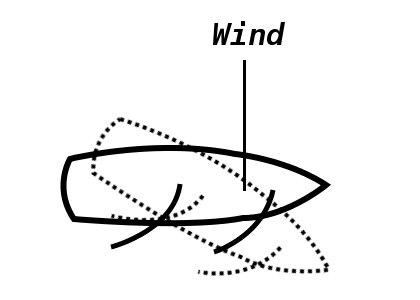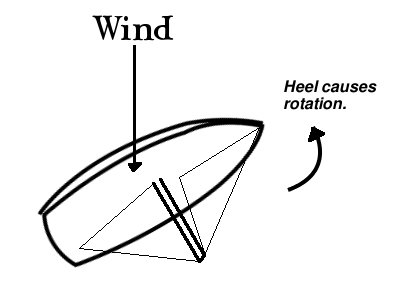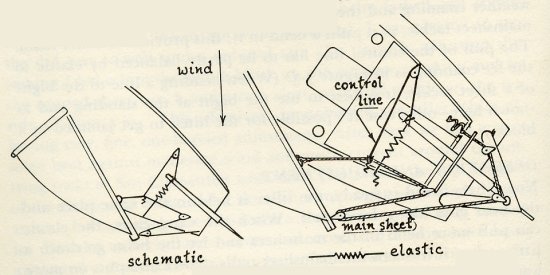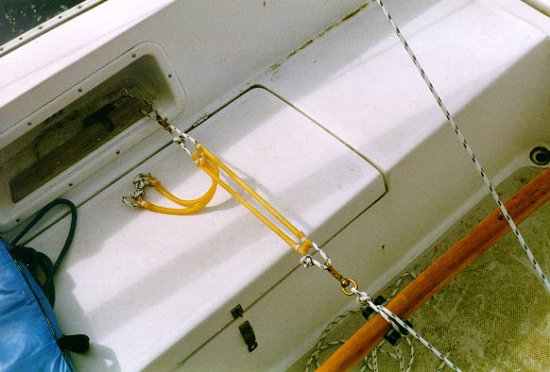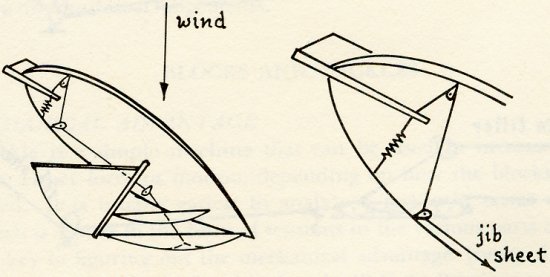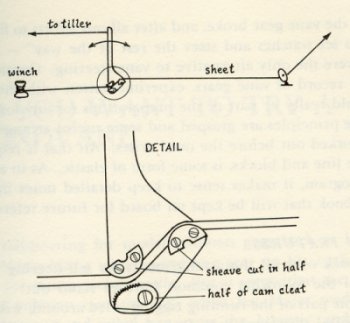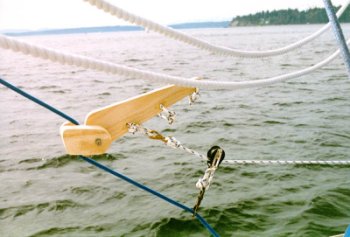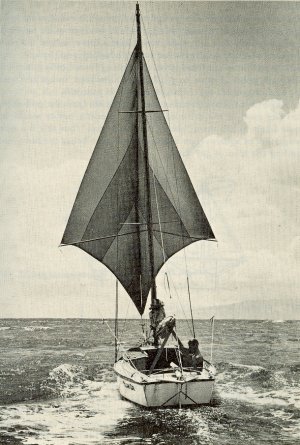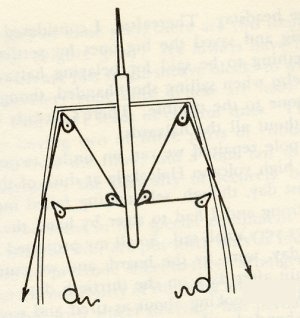 |
| The Golden Hind IV prior to Refit. |
 |
| Navik from Plastimo Altho out of production, perfect for a Vega |
Given that short-handed sailing is the default situation for many boat owners, some kind of efficient self steering system is a huge benefit. Indeed, a decent self steering system can be as useful as two crewmembers – they don’t need to sleep, nor take meal breaks.
Windvane systems are rugged, dependable and won’t drain the batteries – all good reasons why they are the favoured self steering choice of long-term cruisers.
Before buying any type of self steering it’s important to analyse exactly what level of performance you need from the unit – this is a crucial first step in narrowing the many different options and levels of specification. Will the system be mostly to take over briefly while you’re doing other such as making a cup of tea, or to take the boredom out of motoring in a calm? Alternatively, is it to take over when the going gets tough and there are no volunteers to helm, or to steer the boat for long distances on extended passages?
If the answer to either of the first pair of questions is “yes”, an entry-level model may suffice. However, if the answer to either of the second pair of questions – indicating more serious use – is affirmative, this points strongly to a quality model – either windvane or electric – that will be capable of steering the boat for long periods of time in challenging conditions.
Windvane vs electric
There was a time at which any long-distance voyaging boat would sport a windvane self steering gear on the transom. They tend to be robust, often requiring servicing only after tens of thousands of miles, require no electrical input, and can often be easily fixed using locally sourced parts and labour even in remote parts of the world. These remain undeniable advantages in today's world, and many seasoned skippers swear by their wind vane gear for good reason.
On the downside, the upfront cost can be relatively expensive, and windvanes tend not to be effective sailing downwind in light airs, when the apparent wind is low, and are useless for motoring in a calm, when the apparent wind is always from ahead, irrespective of your course. For this reason many yachts with a robust windvane system will also carry an electric pilot, although this does not need to be of a high specification, as it will only be used in easy conditions.
The best electrical systems are now equally capable of steering a boat across an ocean, although carrying spares of key elements of the system is a sensible precaution. On the downside, they can also consume significant amounts of power, making it more of a challenge to keep batteries topped up on a long passage. This can be particularly true for lower specification units that struggle to keep the boat on course, thereby using more power than a system that will steer a better line. Quality electric systems also tend to be preferred by owners of modern lightweight yachts that are designed to sail downwind at planing speeds in strong winds.
Types of windvane
 After first being developed in the post-war years by the likes of Bernard Moitessier, Blondie Haslar and others, windvane design now favours servo pendulum types, which magnify the power produced by the small vane on top of the unit.
After first being developed in the post-war years by the likes of Bernard Moitessier, Blondie Haslar and others, windvane design now favours servo pendulum types, which magnify the power produced by the small vane on top of the unit.A number of companies have with their own designs based on this theme, most of which work on similar principles but offer advantages in terms of size, price or track record. One that stands out from the rest is the Wind Pilot. As an Albin Vega Owner, The Wind Pilot Light is a great choice and in fact operated on countless Vegas as a replacement to the now out of production Navik system.
Here is a video of the new installation of the Pacific Light on the Golden Hind IV:
 The Navik System has been considered for decades to be the answer to windvanes on the Vega. This Windvane has been said to be built as the perfect companion for the Vega. Unfortunately the Navik windvane was bought by plastimo and then put out of production.... Good news on the horizon though as a new windvane system has been developed very similar to the Navik which will be available to the sailing community in the next year or so!
The Navik System has been considered for decades to be the answer to windvanes on the Vega. This Windvane has been said to be built as the perfect companion for the Vega. Unfortunately the Navik windvane was bought by plastimo and then put out of production.... Good news on the horizon though as a new windvane system has been developed very similar to the Navik which will be available to the sailing community in the next year or so! Another windvane which is a fairly young design is the MeVee system. Here is a picture of the MrVee on the Golden Hind IV. This system would work well on some boats but not the Vega. In fact it never really worked right and subsequently has been removed for sale at the next marine swap meet! The main issue was the drive quadrant was way to small and its light construction. It just never worked right and the final straw was when the pendulum paddle slid right off the pendulum shaft in calm seas! What if this had happened offshore?
Another windvane which is a fairly young design is the MeVee system. Here is a picture of the MrVee on the Golden Hind IV. This system would work well on some boats but not the Vega. In fact it never really worked right and subsequently has been removed for sale at the next marine swap meet! The main issue was the drive quadrant was way to small and its light construction. It just never worked right and the final straw was when the pendulum paddle slid right off the pendulum shaft in calm seas! What if this had happened offshore?Beware, Cheaper is not better on a critical part of your sailboat's steering capabilities.
 |
| Golden Hind Tacking Off Cheen Charlotte Strait 27 Knt Nor'easter |
Electric pilots
The simplest electric pilots are the basic all-in-one tiller pilots that just require a 12V power feed, and equivalent basic wheel pilots. If of an adequate size, these can work adequately on smallish boats.
However, the basic unit’s lack of a rate sensing or gyro compass mean that they are not able to respond as quickly and will struggle to keep a boat on course, especially in a quartering sea. In addition, the on deck units are vulnerable to failure as a result of water ingress.
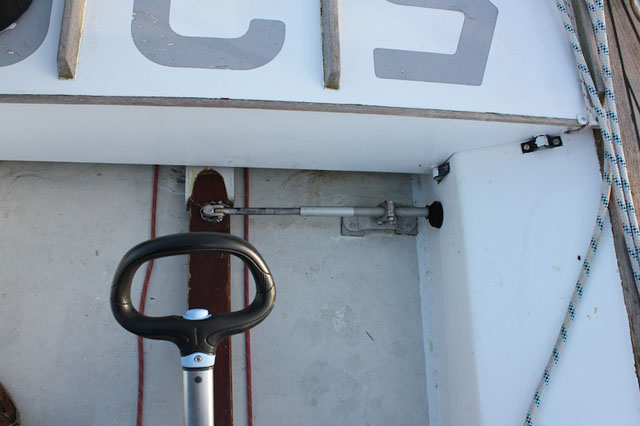
A Bowden cable from a Canadian-manufactured Octopus drive passing through a waterproof gland allows a top specification below-decks pilot to be used on tiller steered boats.
If you’re undertaking serious sailing and opting for an electric pilot, the best you can afford becomes essential. This means a below-deck unit, with a gyro or rate-sensing compass and separate pilot computer. The compass is important here – a lesser model simply won’t provide data to the unit sufficiently quickly. This may well be fine in easy conditions, when the pilot is a useful convenience, but may not work in the kind of heavy weather in which a small crew is likely to depend on the pilot. A further step up will give you a system that also includes a heel angle sensor, which further improves the accuracy of steering.
The right size unit
Manufacturers of all types of self steering gear generally quote recommendations by boat size and length. However, it’s worth noting that many yachts, especially older craft, were built with thicker laminates than the designer originally specified and may well be significantly heavier than the figures quoted by the boat builder. In addition, even boats of a modest size tend to collect a significant weight of additional gear, supplies and crew weight that can easily add a further 20 per cent to the total weight of the boat that must be considered when the pilot is specified.
Balancing the rig
No pilot, whether a windvane for electric model, will work efficiently if the sail plan is not well balanced - paying careful attention to sail trim and shortening sail in good time as the wind increases is crucial to the ease of steering the boat and therefore the performance of all self-steering systems.
Electric pilots allow you to tweak the settings so that the unit will both maintain a reasonable course to windward and tack efficiently across a wide range of conditions and long-distance short-handed racers even talk of trimming their pilot settings in a similar manner to trimming sails in order to get as close to 100 per cent performance as possible. An electric pilot will be only as good as its inputs, so accurate calibration of the instrument system, including compass, masthead wind angle, and boatspeed is also important.
If you are interested in building a windvane steering system, here is a good starting point for ideas.:
http://www.faymarine.com/plansite/fay_marine_yacht_pl.htm


